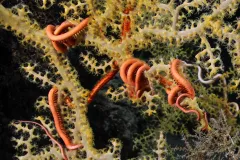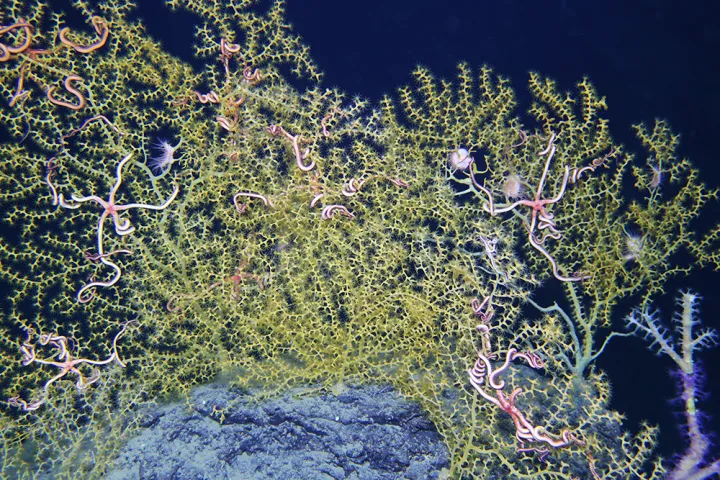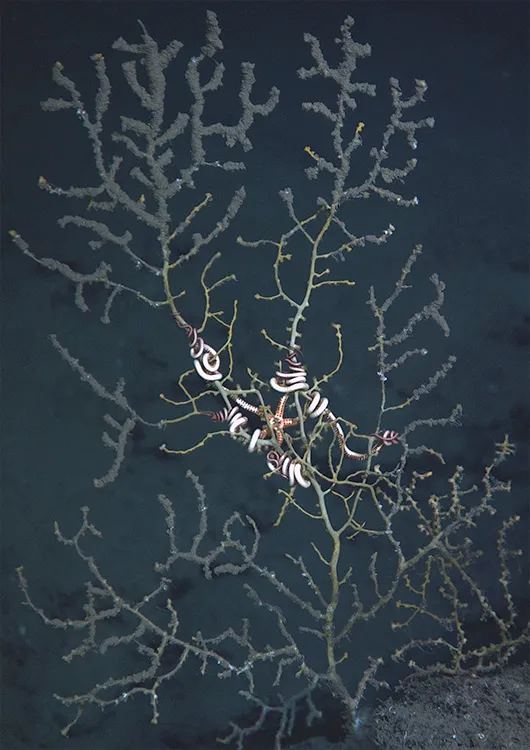A Brittle Star May Be a Coral’s Best Friend

Five thousand feet (1,524 meters) beneath the sea in the Gulf of Mexico, an ancient, coral forest spreads across the seafloor. It’s a vast and eerie landscape void of light. But upon closer inspection a diverse array of critters—crabs, fish, sea stars and anemones—can be seen among the branching arms of the corals. Until recently, scientists considered this to be an example of a one-sided relationship called commensalism. The crabs, worms and sea anemones rely on the corals, potentially for better access to the bits of food raining down from surface waters above, while the corals sit indifferent and unfazed by their co-inhabitants. But it may just be that the corals are getting something out of at least some of these relationships in return.
The Deepwater Horizon oil spill of 2010 created a unique situation for scientists to better understand the relationship between deep sea corals and creatures that sit among their branches. Plumes of oil and gas from the spill drifted down from the surface to the ocean floor. Months after the oil spill, researchers from the Ecosystem Impacts of Oil and Gas Inputs to the Gulf (ECOGIG) consortium, a part of the Gulf of Mexico Research Initiative (GoMRI), began taking high resolution images of deep-sea coral colonies using remotely operated vehicles (ROVs) in an effort to see how the oil spill was affecting the corals.
What they found was concerning. More than half the corals were covered in a smothering, brown substance called “floc.” After testing the floc they confirmed that it contained traces of oil and dispersants from the spill site. Moreover, many corals were producing excess amounts of mucus, showing bare patches of skeleton, and losing polyps—all signs of stress and sickness. A sick coral is also more likely to be covered by hydroids: small, anemone-like animals that are related to jellyfish and compete for space and resources with the coral.
But after four years of monitoring the coral colonies, an interesting trend began to emerge. One particular brittle star, Asteroschema clavigerum, was always found on healthy sections of an octocoral called Paramuricea biscaya, the coral that was the most affected by the spill. This left the scientists wondering: are the brittle stars simply avoiding sick portions of the coral? Or are they actively protecting the corals against damage from the oil spill?
To answer this question, the researchers poured through their collection of photographs to compare corals with at least one brittle star coiled around its branches to corals without a brittle star. They used the proportion of visibly damaged coral branches as a measure of coral health. After comparing corals from three different sites over time the scientists had their answer. Corals with at least one brittle star were healthier than those without. The individual coral branches that were closer to where the brittle star lived were healthier, and when impacted, more likely to recover than branches on the periphery. Even years after the oil spill, the stars stuck with their chosen coral partner. Perhaps the sea stars aren’t freeloaders after all, and in fact live with the corals in mutual symbiosis.
How might the brittle stars be helping the corals? It’s tough to say for sure. Information regarding deep-sea creatures is limited by our ability to get there, a journey that requires some sort of submersible or robotic vehicle. But scientists think they have a pretty good idea. Brittle stars feed by extending their lengthy arms to snatch nutritious particles falling in the water column. A previous study of corals in New Zealand fjords showed that a mutualistic sea star was able to brush away potentially smothering sediments following catastrophic landslides simply through feeding movements. It’s believed the same holds true for oil contaminants. The stars may also deter hydroid larvae from settling on the coral’s branches.
Deep-sea corals can be thousands of years old. Damage to a particular branch is a costly blow considering a single branch may have taken hundreds of years to grow. This study of corals coping with an oil spill shows that a seemingly insignificant brittle star clinging to its branches may be a deep-sea coral’s first line of defense. But even the best of friendships have their limits, as the oil spill caused the numbers of these defenders to decline. Here’s to hoping that as the impact of the oil spill declines over time, more brittlestars will return to the corals that depend on them.
---
The Ocean Portal receives support from the Gulf of Mexico Research Initiative (GoMRI) to develop and share stories about GoMRI and oil spill science. The Gulf of Mexico Research Initiative (GoMRI) is a 10-year independent research program established to study the effect, and the potential associated impact, of hydrocarbon releases on the environment and public health, as well as to develop improved spill mitigation, oil detection, characterization and remediation technologies.
For more information, visit http://gulfresearchinitiative.org



